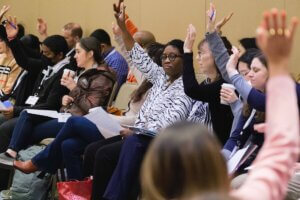Why is building a Logic Model important for your program?
Building a logic model is a foundational step in program evaluation. A logic model outlines what your program is trying to achieve and lays the groundwork for all of your evaluation activities.
Key concepts we’ll explore in this chapter:
- Program inputs and assumptions
- Program outputs vs outcomes
- Short term, intermediate, and long-term outcomes
-
Introducing the Super Scholars Program  In this module, we’ll start each chapter by following the journey of Super Scholars, a fictional mentoring program that is in the process of building its capacity for program evaluation.
In this module, we’ll start each chapter by following the journey of Super Scholars, a fictional mentoring program that is in the process of building its capacity for program evaluation.Take a moment to read about Super Scholars and learn about a few of its goals and challenges related to program evaluation:
-
starting evaluation work with a logic model One of the more challenging tasks for a mentoring program is defining and demonstrating exactly how, and under what conditions, the mentoring provided by caring adults is expected to lead to desired changes in the attitudes, behaviors, and accomplishments of the youth served. A logic model is a graphical representation of how a program’s resources and activities work toward creating an intended change. A logic model serves as a road map that can help programs like Super Scholars evaluate their program at multiple levels, including critical outcomes for youth.

Take a moment to review Super Scholars’ logic model, and then we’ll explore each component in depth.
-
inputs Inputs:
- School concern about students with academic and behavioral challenges
- Half-time coordinator
- Teachers
- School staff members
- Six local business partners
- Two hours of available contact per student per week
- Program curriculum
- Volunteers from local businesses
- School space
- School performance records
- Relationship surveys
Inputs are the resources that support or drive your program, including money, time, employees, expertise, facilities, and even the needs of community members.
When drafting inputs, Super Scholars started by identifying the demands for its services:
Demands: Community requests
Next, it identified the program resources that are necessary to provide services:
- Financial resources: Funding sources
- Community resources: Partnerships, consultants, mentors, youth, families
- Program resources: Leadership, staff members, curriculum
- Infrastructure: Software, physical space
-
activities Activities
Leadership
- School planning meetings
Program Staff Members- Mentor schedule coordination
- Mentor support and supervision calls/emails
- Mentor recruitment
- Mentor training
- Mentor survey
- Mentee survey
- End-of-year celebration
Participants- Board games
- Sports and recreational activities
- Mindset “sparks” curriculum
- Study skills training
- Conflict management instruction
- Goal setting
Activities are the actions, events, products, or services of the program. Activities represent the planned work that is necessary to produce outputs.
When drafting activities, Super Scholars found it helpful to organize them by different roles:
Leadership activities
- Securing program funding, building partnerships, engaging in strategic planning
Program staff member activities
- Recruiting, screening, matching, training, and monitoring program participants
Participant activities
- Completing the program curriculum, completing evaluation forms
-
Assumptions Assumptions articulate the underlying beliefs about how your program will work. Super Scholars outlined two types of assumptions in its logic model:
Program-related assumptions: How it assumes that its inputs and activities will produce outputs and outcomes.
- It can be helpful to frame program-related assumptions using “If … then” statements.
Contextual assumptions: The conditions in the community that will need to be true for the program to operate as intended.
- These types of assumptions may or may not be helpful to frame as “If … then” statements.
Assumptions:
- IF mentors receive at least two contacts from supervisors per semester, THEN they will be better equipped to address mentees’ needs.
- IF mentees and mentors meet at least two times a week, THEN they will be able to develop a rapport and a stronger relationship.
- Support for the program from volunteers and local businesses will continue to be available.
-
Outputs Outputs:
Administrative
- 45 mentors recruited
- 45 mentors complete two hours of training
- 45 students referred
- 45 mentees matched
- At least 40 relationship satisfaction surveys returned
- Mentors receive two contacts from supervisors per semester
- 45 mentors receive ongoing training
Program
- One hour of mentoring per session
- Two mentoring meetings per week
- Mentors spend 50 percent of the time on fun and recreational activities
- Mentors spend 50 percent of the time on the curriculum
- Mentors complete the curriculum
- Mentors complete one hour of ongoing training during the fall or spring semester
Outputs are the expected “products” immediately produced by the activities. Outputs should be directly observable and recordable. When drafting outputs, consider frequency, latency, and duration.
Frequency means counting instances of something (e.g., matches, meetings, trainings, mentors)
- Number of mentees being mentored
- Number of mentors recruited
- Percentage of surveys completed
Latency is the delay between two events
- For example: The time between applying to be a mentor and being matched, on average, is less than eight weeks
Duration is the length that something lasts (e.g., relationships, access to ongoing support)
- For example: Matches last an average of 10 months
Super Scholars has organized outputs into two categories: administrative and program.
-
Outcomes  Outcomes are the changes in knowledge, skills, life circumstances, behavior, status, level of functioning, and/or attitude that mentees experience as a result of program activities. Some programs may also include outcomes for mentors and the program setting (such as improving school climate or reducing youth violence in the community). As a general rule, outcomes are not part of the program itself — they are experienced as a result of being in the program. A good check in this regard is whether the outcome could be experienced by a non-participant. If not, it is probably an input rather than an outcome.
Outcomes are the changes in knowledge, skills, life circumstances, behavior, status, level of functioning, and/or attitude that mentees experience as a result of program activities. Some programs may also include outcomes for mentors and the program setting (such as improving school climate or reducing youth violence in the community). As a general rule, outcomes are not part of the program itself — they are experienced as a result of being in the program. A good check in this regard is whether the outcome could be experienced by a non-participant. If not, it is probably an input rather than an outcome.
Examples of other youth outcomes for mentoring programs might include :
- Increase in health-related knowledge/attitudes
- Increase in positive mental health (e.g., happiness, life satisfaction)
- Increase in quality of relationships with parents/guardians, peers, and other adults
- Decrease in risky behaviors
-
Drafting Outcomes Outcomes:
Short-Term
- Positive relationships with mentors
- Stronger academic-enabling skills
- Higher academic self-efficacy
Intermediate
- Improved mentee grades
- Strong motivation to attend college
- Better study skills
Long-Term
- School matriculation
- College attendance
Super Scholars has big hopes and dreams for its mentees. One of its long-term outcomes is that the program will help mentees increase their likelihood of attending college. However, to reach that long-term outcome, the program might have to first focus on some short-term or intermediate outcomes, such as increasing mentees’ motivation to focus on academics or developing strong study skills in middle school.
Although it can be very inspiring to identify long-term outcomes in your logic model, it’s important to think about your program outcomes in stages. Start by working backward from those long-term outcomes and consider what changes might lead to them.
-
Developing your own logic model (Activity) Having a well-developed logic model is an essential first step in program evaluation.
If your program has a logic model: Print a copy and review each of the components alongside the guidance in this module. After that, individually or with your program team, revise your logic model.
If your program does not have a logic model: Fill out the “Logic Model Worksheet” with your program team. When getting started, it can help to discuss each of the components in reverse order, starting with your program outcomes.



